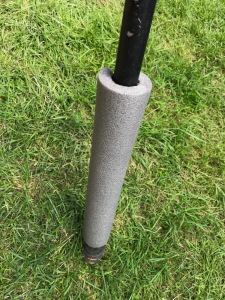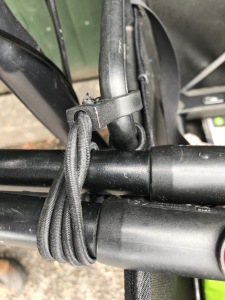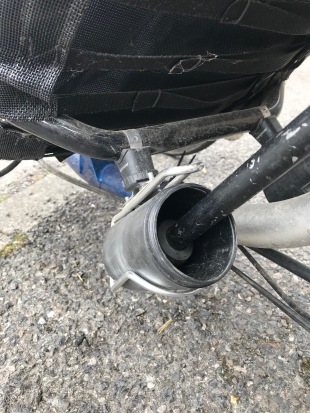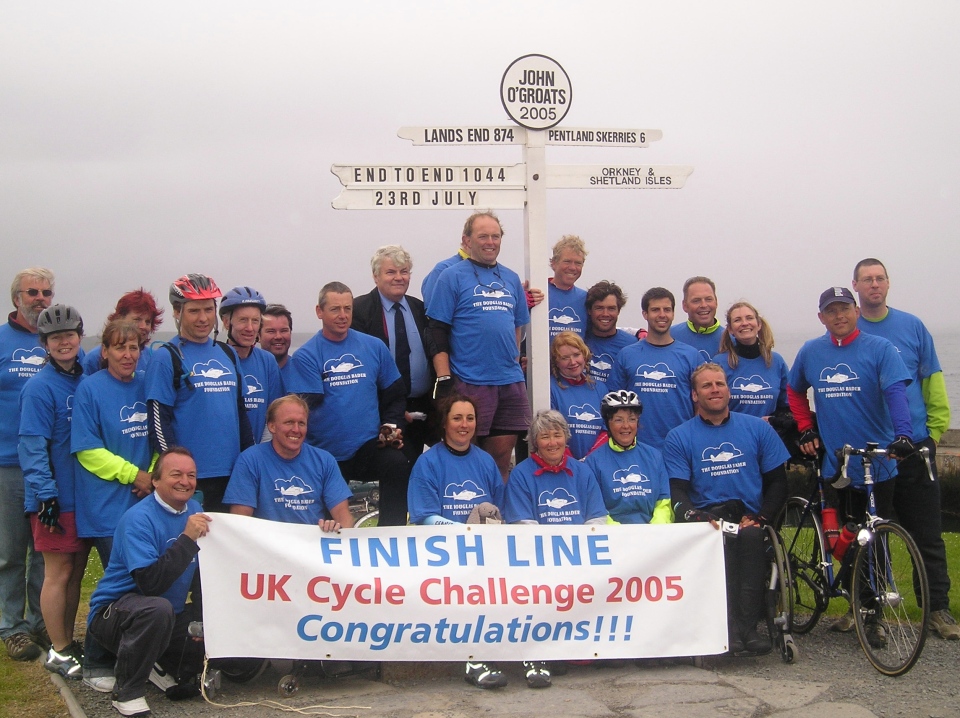I used to despise blister paving. Sounds extreme now, but when it began to appear, seemingly out of nowhere, that response felt fully justified. At the time any lumps and bumps could be problematic, but when someone went out of their way to design what was for me a hazard and place it my path without any consideration for how it would affect me, it elevated tactile paving into a more significant issue than all the existing crap I had to deal with.
It was a long time in coming – almost thirty years – but a solution eventually arrived that eliminated most of the problems I encountered with tactile paving and all the other flat-on-my-face hazards to do with surface variation and slopes. That was in 2009 and it came in the form of a new type of knee for my prosthesis1 which, other limitations notwithstanding, gave me the ability and the confidence to go pretty much anywhere in an urban environment because I could trust it not to collapse.
What’s that got to do with crossing cycle tracks? Aside from the link between blister paving and crossing points, it’s an experience I can draw on to understand how someone might react when their environment is adversely altered having not been consulted. One such example being the RNIB’s response to TfL’s proposed changes outside its offices in Judd Street.
Cycling advocates will be familiar with trying to draw what they consider to be a safe cycle network onto a map of their local area. The parts that qualify are often so few and far between that any network is almost nonexistent, or so fractured there are only one or two complete routes and those require a lot of local knowledge to find and follow. I imagine there must be people carrying out the same exercise to assess and map walking networks for blind people, with similar outcomes, but with an added investment in time and effort to memorise the routes with far fewer cues as to location. Disrupting a popular, safe cycle route is going to trigger an emotive response, so no surprise that threatening to disrupt an important link in the mobility network of blind people elicits the same.
Yet the RNIB’s response did surprise cycling advocates. Despite subjective safety being a well understood concept in cycling circles, statistical arguments about the reduction in motor vehicle movements were being used to counter the objections, and the significance of replacing a pelican crossing with a zebra crossing was completely missed. The conclusion I draw from that is transport planners and cycling advocates are not attuned to, or are misunderstanding, what blind people perceive to be a safe environment.
For a typical pedestrian, crossing a ‘filtered’ Judd Street is likely to be a trivial task; making use of the pelican crossing without waiting to activate it or probably not using it at all and following a desire line. For a blind pedestrian in a street with a lot of cycle traffic the need for a safe crossing point with a safe crossing time isn’t going to disappear with the motor traffic, and listening to the comments of blind people a significant proportion of them do not consider zebra crossings to be sufficiently safe. In 2014 Guide Dogs commissioned a report Road and street crossings for blind and partially sighted people which is subtitled The importance of being certain – and that’s the key point, the lack of certainty in when it’s safe to step off the pavement means zebra crossings are not considered a subjectively safe solution by blind people.
That doesn’t only hold for a filtered Judd Street, it will also apply to a bus stop bypass. I hear through the grapevine that a working group of stakeholders have found that evidence gathered to date from monitoring bus stop bypasses shows that they are not inherently dangerous. That’s good news, however, if blind people are avoiding these bus stops because they don’t consider them to be safe, they are effectively excluded from the evidence base being considered. It’s essentially the same argument cycling advocates use to explain the lack of underrepresented groups cycling in a hostile environment – a lack of subjective safety leads to self exclusion and no amount of stats proving how safe it is for the people who do cycle, or training in how they do it, significantly alters that.
What would make crossing a cycle track subjectively safe for a blind person? The obvious answer is the thing blind people keep asking for, a signal controlled crossing, but currently I would guess there isn’t a design that suits the smaller scale of a bus stop bypass. So what might a small-scale signal controlled crossing look like?

The image above is a view of an informal crossing at a bus stop bypass on Blackfriars Road. The camera is looking towards St George’s Circus, the asphalt cycle track running between the pavement and the bus stop is about 3m wide and rises to pavement level at the buff coloured, perpendicular informal crossing, which is also about 3m wide. It’s not a busy bus stop and I’ve chosen it simply because it suits my purpose and the photo was easy to lift from Twitter – thanks @Phil_PJA!
I’ve superimposed a partial cross-section onto the photograph showing the components embedded within the street surface that might make up this imagined controlled crossing – there are no poles. Most people would continue to use it as an informal crossing, but blind people in particular could activate it to stop cycle traffic and find out when it’s safe to cross. Here’s how the crossing might operate with reference to the standard components that are being replaced or altered:
- The button: a person activates the controlled crossing by standing on the pressure sensitive blister paving panel. The panel vibrates to acknowledge the user request to cross.
- The stop light: a strip of red LEDs embedded in the cycle track flash to stop approaching cycles.
- The motion sensor: the LED strip contains a motion sensor to determine when it’s safe to cross. (This is an additional function compared to existing signal controlled crossings and is possibly overkill – the existing time delay before the next step is probably sufficient.)
- The tactile knob and audible beep: The blister paving panel vibrates and beeps for as long as it takes to cross, after which the red LEDs stop flashing.
The proposed pressure sensitive, vibrating, beeping, blister paving panels (acronym required) on either side of the crossing would contain the control circuitry and be solar powered. This self contained design has the potential to keep the cost of installation to a minimum and the technology used already exists:
- Solar City are manufacturing roof tiles with a process that would probably suit blister paving. Could a non-slip surface be incorporated too?
- The force sensing and vibration is a scaled up version of Apple’s taptic engine. Would vibrating a whole human be too tall an order for it?
- Motion sensing’s nothing new, assuming it can be tuned sufficiently to reliably sense approaching cyclists.
- Embedded lighting has been used to stop motor vehicles at cycle crossings in the Netherlands.
- In addition to the crossing functionality the blister paving panels could integrate beacons to aid navigation forming part of a network throughout towns and cities.
Could it work? At this year’s Disability Studies Conference one of the authors of the Guide Dogs report mentioned earlier, Bryan Matthews, presented a paper Where To Go Next? Technology and visually impaired people’s mobility in which he advised some caution in relying on technological solutions that require users to equip themselves with additional devices. Expense, complexity, reliability and sensory overload being some of the reasons that mean seemingly promising solutions may not work as well as first envisaged. What I’m proposing here, like my new knee, is a technological solution, but it doesn’t rely on the user having an additional device or on a third-party’s system. It’s essentially a reconstruction of an existing solution.
How might its feasibility be tested? PAMELA springs to mind. Back in April, Mobility for an Ageing Population included a tour of the Pedestrian Accessibility & Movement Environment Laboratory in Tufnell Park, which as well as being a research facility seemed to have people with all the skills needed to put something like this together. I can’t see the obvious flaw – yet – but there could be any number of reasons why it wouldn’t be successful in practice: counterintuitive; confusing; the vibrations spook guide dogs; the electronics drown in flash floods; not enough incident light to power it. Whatever the outcome though, I’m convinced a more inclusive solution than the ones currently available is required.
Architects and planners have been pursuing an uncluttered place-making aesthetic, loosely referred to as Shared Space, giving little apparent thought to, or making false assumptions about, how people with different constraints and capabilities will move through these places safely and efficiently. I’ve deliberately taken into account this emphasis on place-making with a visually unobtrusive design, while at the same time (I hope) maintaining a clear, formal method to interact with other modes (people on bikes, in cars, etc) for those pedestrians who need it in order to feel comfortable with using the space. In this case it’s a bus stop bypass, but the same could be applied to other contexts such as Exhibition Road or Frideswide Square.
Bearing in mind the cost of granite paving, surely it’s possible to design pleasant places to be without having to sacrifice anybody’s mobility and independence. Should anyone in the business get this far, consider that a gently tossed gauntlet.
 Because I have no right leg there’s no chance of the crutches getting in the way – bipeds might want to get the crutches as central as possible to prevent them from interfering, but I can’t guarantee that they won’t. This version of the basket pictured with the handle is no longer available, however the new version has a webbing strap that you can loop the shock cord through and will probably help get the crutches slightly more central at the front.
Because I have no right leg there’s no chance of the crutches getting in the way – bipeds might want to get the crutches as central as possible to prevent them from interfering, but I can’t guarantee that they won’t. This version of the basket pictured with the handle is no longer available, however the new version has a webbing strap that you can loop the shock cord through and will probably help get the crutches slightly more central at the front. y need a temporary fix I’ve found some pipe lagging around each crutch protects the frame of the bike and along with Brompton shock cords works tolerably well. If you’ve got a pair hanging around in the shed then toe straps are a handy way of securing them too – I used those to begin with. Over the long term though, wrapping the shock cord or tightening the toe strap round the crutches and getting it secure becomes a chore compared to just snapping them in and out of pipe clips.
y need a temporary fix I’ve found some pipe lagging around each crutch protects the frame of the bike and along with Brompton shock cords works tolerably well. If you’ve got a pair hanging around in the shed then toe straps are a handy way of securing them too – I used those to begin with. Over the long term though, wrapping the shock cord or tightening the toe strap round the crutches and getting it secure becomes a chore compared to just snapping them in and out of pipe clips.

















